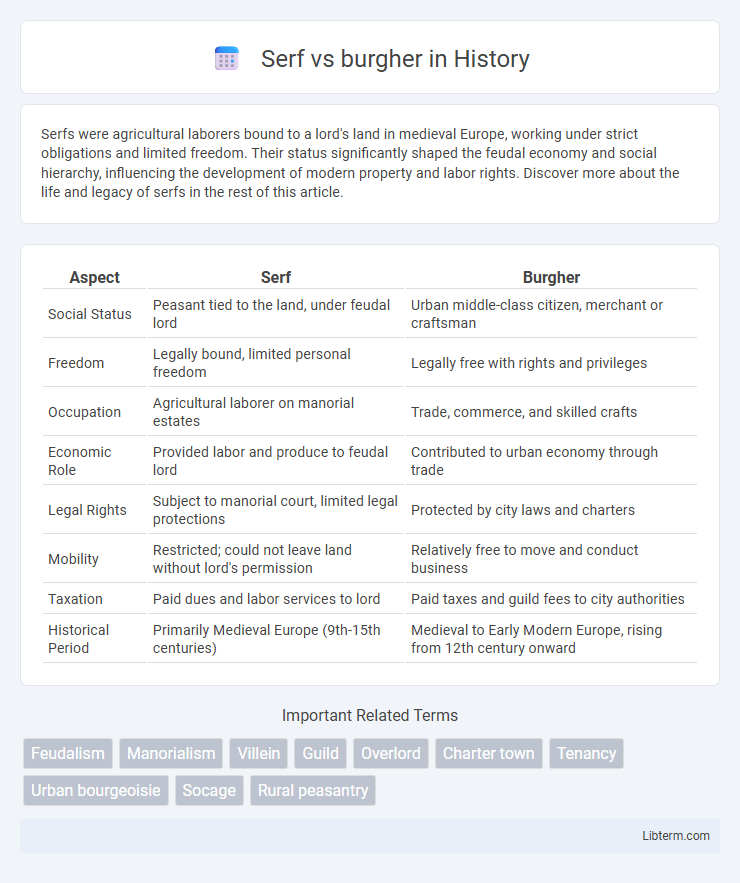Serfs were agricultural laborers bound to a lord's land in medieval Europe, working under strict obligations and limited freedom. Their status significantly shaped the feudal economy and social hierarchy, influencing the development of modern property and labor rights. Discover more about the life and legacy of serfs in the rest of this article.
Table of Comparison
| Aspect | Serf | Burgher |
|---|---|---|
| Social Status | Peasant tied to the land, under feudal lord | Urban middle-class citizen, merchant or craftsman |
| Freedom | Legally bound, limited personal freedom | Legally free with rights and privileges |
| Occupation | Agricultural laborer on manorial estates | Trade, commerce, and skilled crafts |
| Economic Role | Provided labor and produce to feudal lord | Contributed to urban economy through trade |
| Legal Rights | Subject to manorial court, limited legal protections | Protected by city laws and charters |
| Mobility | Restricted; could not leave land without lord's permission | Relatively free to move and conduct business |
| Taxation | Paid dues and labor services to lord | Paid taxes and guild fees to city authorities |
| Historical Period | Primarily Medieval Europe (9th-15th centuries) | Medieval to Early Modern Europe, rising from 12th century onward |
Introduction to Medieval Social Classes
Serfs were agricultural laborers bound to the land, forming the lower class in medieval feudal society, while burghers were town-dwelling merchants and craftspeople representing the emerging middle class. The serf's obligations included working the lord's estate and paying dues, contrasting with burghers who engaged in trade and commerce, contributing to urban economic growth. This social distinction highlights the rigid hierarchy and evolving economic dynamics of medieval Europe.
Defining Serfs and Their Role
Serfs were agrarian laborers legally bound to a lord's estate, providing essential agricultural work in medieval feudal society. Their role was characterized by limited mobility and obligations such as crop production, maintenance of land, and various forms of serfdom dues. This status distinguished them from free urban occupants like burghers, who engaged in trade and commerce within towns.
Understanding the Burgher Class
The burgher class in medieval Europe consisted of wealthy town dwellers who gained economic power through trade, crafts, and commerce, distinguishing them from serfs bound to rural feudal estates. Unlike serfs, who were legally tied to the land and owed labor services to their lords, burghers enjoyed personal freedom, legal privileges, and often participated in municipal governance. Understanding the burgher class reveals the rise of urban economies and the gradual shift from feudal agrarian society to early capitalist structures.
Origins and Historical Context
Serfs originated in medieval Europe as agricultural laborers legally bound to the land owned by feudal lords, primarily emerging during the early Middle Ages following the collapse of the Roman Empire. Burghers, in contrast, were members of the emerging urban middle class in medieval towns and cities, gaining prominence from the 11th century onward through trade, commerce, and guild membership. The distinct origins reflect the contrasting socio-economic structures: serfs tied to rural manorial economies, while burghers thrived in the growing market economies of medieval urban centers.
Legal Status and Rights
Serfs were legally bound to the land and subject to the authority of their lords, possessing limited rights such as customary use of land but lacking freedom of movement or property ownership. Burghers, typically urban dwellers or merchants with recognized citizenship in towns, held legal privileges including property ownership, self-governance through guilds, and protection under municipal laws. The stark contrast in legal status granted burghers significant economic and personal freedoms, whereas serfs remained dependent on feudal obligations and vulnerable to manorial jurisdiction.
Economic Roles and Livelihoods
Serfs primarily engaged in agricultural labor, tied to the land under feudal obligations, producing crops and livestock that sustained the manor economy. Burghers, residing in towns and cities, participated in commerce, crafts, and trade, driving urban economic growth through guild membership and market activities. This division of labor reflected the rural-agrarian foundation versus the emerging urban mercantile economies in medieval Europe.
Daily Life: Serf vs Burgher
Serfs lived under feudal obligations, working the lord's land daily with limited personal freedom, while burghers engaged in commerce and crafts within towns, enjoying more autonomy and economic opportunities. Serfs' daily routines centered on agricultural labor from dawn to dusk, whereas burghers managed shops, participated in guilds, and controlled trade activities. The contrast in their daily lives highlights the division between rural agrarian servitude and urban mercantile independence in medieval society.
Social Mobility and Restrictions
Serfs were tied to the land with limited social mobility, bound by feudal obligations that restricted their freedom to change status or occupation. In contrast, burghers, as town-dwelling merchants or craftsmen, experienced greater social mobility through trade, guild membership, and economic success within medieval urban centers. The rigid hereditary restrictions on serfs contrasted sharply with the relative flexibility and opportunity for wealth accumulation enjoyed by burghers.
Serfs and Burghers in Urban vs Rural Settings
Serfs primarily inhabited rural settings, bound to agricultural labor on their lord's land with limited personal freedom and economic opportunities. Burghers resided in urban environments, enjoying greater rights, engaging in commerce, and contributing to the growth of medieval towns through trade and guild membership. The contrasting social roles highlight the economic and legal divide between rural serfs tied to feudal obligations and urban burghers who thrived in emerging market economies.
Long-Term Impact on European Society
Serfs, bound to the land and subject to feudal lords, maintained a rigid agrarian economy that delayed urban development and social mobility in medieval Europe. In contrast, burghers, as members of growing urban merchant and artisan classes, fostered economic diversification, trade expansion, and the rise of early capitalism. The long-term impact of this dichotomy shaped the transition from feudalism to modern state structures, influencing social stratification and the economic foundation of European city-states.
Serf Infographic

 libterm.com
libterm.com